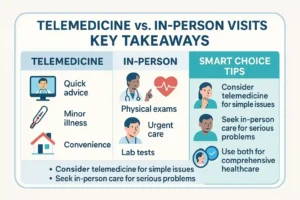Key Takeaways
- Telemedicine enables consultations with doctors from the convenience of your home via phones or computers.
- The benefits of telemedicine include fast access, comfort, and easier scheduling.
- An in person doctor visit is still better for physical exams and serious conditions.
- Choosing between the two depends on your health needs and the type of care you’re looking for.
- For routine check-ups, video consultations with doctors might be enough. However, for emergencies, nothing surpasses in-person medical visits.

Table of Contents
Toggle
Understanding Telemedicine
Telemedicine refers to receiving medical assistance without the need to visit a clinic or hospital. You talk to your doctor using your phone, tablet, or computer. It could be through a video call, voice call, or even chat.
It’s like seeing your doctor online instead of face-to-face. Many people today prefer it for regular check-ups, follow-ups, and small health problems. It’s a form of virtual healthcare that works well if you don’t need a physical check.
Following the COVID-19 epidemic, telemedicine has grown in popularity. Clinics and hospitals now offer online medical appointments for many health issues. Some people even talk to a specialist from another city or country. This means access to specialists online is easier than before.
The Benefits of In-Person Visits
There are many good things about an in person doctor visit:
- It’s best for problems where touch, tests, and exams are needed.
- Doctors are able to detect underlying issues during a physical examination.
- Tests and treatment can be received at one location.
- Easy to build long-term care with your doctor.
- Important for kids, older people, and those with long-term diseases.
Here’s what you can expect during a telemedicine session:
- Telemedicine appointments can be done from home or even when you travel.
- You can use any gadget, including laptops, tablets, and cell phones.
- The doctor will ask you about your symptoms, look at you on camera, and may check past reports.
- You might be asked to show parts of your body on camera, like a rash or a swelling.
- The doctor will give advice, send a digital prescription, or ask you to visit in person if needed.
This type of online patient care is fast and easy when you just need to talk or get advice.
The Benefits of Telemedicine
There are many benefits of telemedicine. Here are some simple ones you’ll love:
- Doctor visits from home mean you don’t waste time in traffic or waiting rooms.
- It’s fast and can be done from anywhere. That’s called convenient medical care.
- Perfect for people who live in far-off places or can’t travel.
- Easy access to doctors even at night or during weekends.
- Cheaper than hospital visits in many cases.
The real advantages of telemedicine come when you have a minor illness like a cold, skin allergy, or stomach upset. You don’t need to travel and wait to be seen.
The Limitations of Telemedicine
Even with many good things, telemedicine has some limits.
- You can’t do lab tests, X-rays, or scans online.
- A doctor can’t check your heartbeat or take your blood pressure on video.
- Some problems need a touch or check-up, which is only possible in person.
- Internet problems or poor video can make it hard to talk clearly.
- Not all doctors offer online medical appointments for every condition.
Also, in some serious cases, you will need an emergency medical visit. Online care can’t help when you need urgent treatment.
Understanding In-Person Visits
An in person doctor visit means you go to a clinic or hospital to meet your doctor directly. This is the oldest and most common way people get treatment.
In-person care constitutes the core of traditional healthcare appointments. Here, the doctor checks your body, listens to your heart or lungs, presses your tummy, looks into your eyes, and more. These things cannot be done in video consultations with doctors.
This type of visit gives a full and real-time check-up. It also builds trust between you and the doctor because you’re meeting face-to-face.
Key Features of In-Person Visits
During a face-to-face doctor visit, you can anticipate:
- Physical exams and testing on the spot.
- Face-to-face talk about your health.
- In-clinic lab tests, scans, and injections.
- A better chance for the doctor to notice small things about your health.
- Clearer understanding of what’s going wrong.
This form of care, also known as a traditional healthcare consultation, helps doctors give a deeper and more accurate look at your health.
The Benefits of In-Person Visits
There are many good things about an in person doctor visit:
- It’s best for problems where touch, tests, and exams are needed.
- Doctors are able to detect underlying issues during a physical examination.
- Tests and treatment can be received at one location.
- Easy to build long-term care with your doctor.
- Important for kids, older people, and those with long-term diseases.
Some people feel more sure and safe after face-to-face medical visits. That’s why many still prefer going to a clinic even for smaller issues.
The Limitations of In-Person Visits
But yes, in-person visits also have downsides:
- You have to travel and wait, which takes time.
- In crowded cities, reaching the doctor can be hard.
- It’s costly in some places.
- You may risk catching germs in hospitals or waiting rooms.
- Not easy for people with disabilities or chronic pain.
Even though an in person doctor visit is important, it’s not always the best choice for small, common issues.

Finding the Right Balance
Choosing between telemedicine and an in person doctor visit is not always simple. It depends on your needs, comfort, and health issues.
Go with telemedicine if:
- You have a minor cold, rash, or follow-up.
- You want quick advice or help.
- You can’t leave your home.
Go with an in person doctor visit if:
- You need physical exams or urgent tests.
- Your problem involves pain, swelling, or severe symptoms.
- You’re going for your first check-up.
Many people now use both. This way, they get the convenient medical care of online patient care, but also the safety of real-time checks during traditional healthcare visits.
This balance is the smart way forward; a mix of telemedicine vs in-person care that gives you both speed and depth.
Conclusion
Choosing between telemedicine and an in person doctor visit doesn’t have to be confusing. Ask yourself: “Do I require an actual check-up or merely a conversation?” If it’s the second, telemedicine can save you time, money, and effort.
Still, don’t forget the power of face-to-face medical visits. Some things need real eyes, hands, and ears to solve. So, next time you’re unwell, think smart. Choose the care that fits your needs, not just the trend.
In today’s world, smart healthcare is about flexibility. Just pick the right one, at the right time.
FAQs
What is telemedicine?
Telemedicine lets you consult a doctor remotely using your phone, tablet, or computer. It’s useful for minor issues, follow-ups, and advice without visiting a clinic physically.
What are the advantages of telemedicine?
The advantages of telemedicine include quick access to doctors, less travel, flexible timing, and digital prescriptions. It’s perfect for non-urgent problems and managing long-term conditions.
Are in-person visits better for certain conditions?
Yes. An in person doctor visit is best for physical exams, serious health problems, lab work, or emergencies that can’t be handled online.
How does the quality of care compare between telemedicine and in-person visits?
Both offer quality care, but an in person doctor visit provides hands-on exams. Telemedicine works well for simpler needs and saves time for both doctor and patient.
What types of appointments can be conducted via telemedicine?
Telemedicine is ideal for colds, allergies, follow-ups, and mental health talks. These online patient care sessions avoid clinic visits and support care from anywhere.

This article is medically reviewed by Dr. Chandril Chugh, Board-Certified Neurologist, providing expert insights and reliable health information.
Dr. Chandril Chugh is a U.S.-trained neurologist with over a decade of experience. Known for his compassionate care, he specializes in treating neurological conditions such as migraines, epilepsy, and Parkinson’s disease. Dr. Chugh is highly regarded for his patient-centered approach and dedication to providing personalized care.








